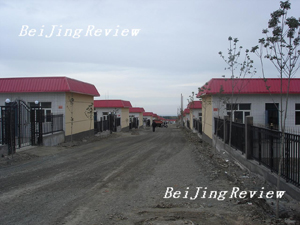| 
Driving 110 km toward famous tourist attraction Tianchi Lake from Urumqi, capital of the Xinjiang Uygur Autonomous Region, clusters of yurts can be seen alongside the winding road, set amid the trees. The traditional nomads' homes all look new, each with a number printed on the door. Then a signpost catches the eye: It reads "Welcome to the Kazakh Folklore Village!"
Marziya, 39, is the owner of one of the yurts. She is a Kazakh who raised cattle more than 10 years ago on the other side of Tianchi Lake. "We used to be herdsmen and barely did any business except for selling some smoked horse meat," she said.
Official figures show there are about 1.4 million Kazakhs in Xinjiang, accounting for 7 percent of the total population in the autonomous region.
Marziya's yurt is No. A-2, the second yurt in the A section. According to Marziya, there are three sections in this folklore village, with sections A and B completed and section C still under construction.
"We have 58 households in section A. Each household owns two yurts, a bigger one and a smaller one. The bigger one is to accommodate tourists and the smaller one is where we live and prepare food for the guests," she explained.
Both yurts share the same cement base. According to Marziya, the local government invested a total of 10 million yuan in constructing the folk village.
Last year there was a flood and most of the old yurts were destroyed, so the government allocated a large sum of money to rebuild their homes. "The government spent about 100,000 yuan for each family, including the cement base, the construction of the two yurts and water and electricity supplies," said the owner, adding that the residents have to pay only 300 yuan a year for management expenses.
It costs about 150 yuan per day to rent a yurt. Each is decorated differently, according to the taste of the owner. Tourists can eat, sleep and sing karaoke inside the yurt. The food served here is home-style.
"Sometimes I hire a dance team to perform for our guests," said Habieke, owner of another yurt in the folk village.
Habieke, also a Kazakh, used to be a tour guide and has sold handicraft articles for some time.
"Since I took up the folk tourism business here several years ago, I'm doing better and better. Last year I made a net profit of some 80,000-90,000 yuan," he said.
Habieke is too busy to run his business alone and he employs two workers to help him.
In this way, herdsmen participate in the service industry and immediately have their income increased, which is an important objective of rural development.
What's more, as herdsmen become settled residents, it is good for the environment, since grazing does some harm, said Qin Xiaoling, a local official.
From farmer to hotel manager
Only 50 km from the capital city Urumqi, Shuixigou Township is located adjacent to the Southern Mountain scenic spot, which has a favorable climate that is cool in summer and warm in winter.
Given the climate advantage, Fangjiazhuang Village, under the jurisdiction of Shuixigou Township, has developed the farmhouse hotel business. According to the village Party branch secretary, Xian Hui, the village finished reconstruction work in 2003, with all the old houses torn down and new ones built. The construction of each farmhouse cost 110,000 yuan, with 60,000 yuan paid by farmers and the rest coming from a government subsidy.
This village used to be poverty-stricken, with a small agricultural production of wheat and potatoes, but it now receives a tourist population that is growing year by year. In 2005, there were 56,000 visitors, and that number has risen to 73,000 so far this year.
"I didn't quite understand the point of tearing down my house and rebuilding it until the next year, when I made a net profit of 100,000 yuan through accommodating the tourists," said village resident Xian Hui.
| 